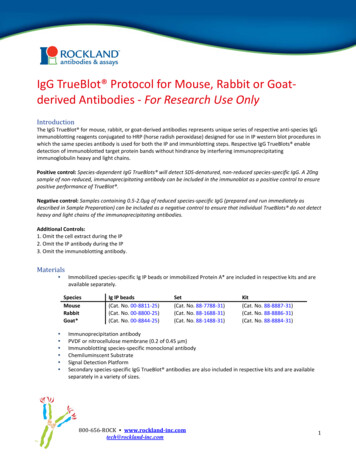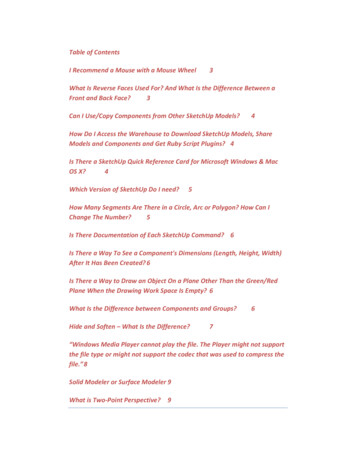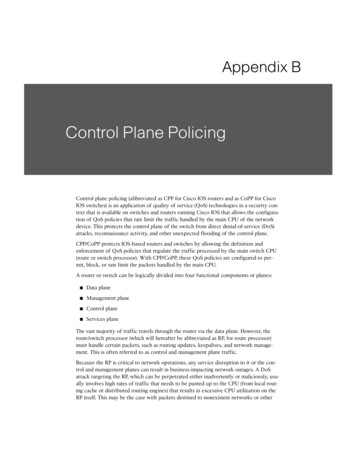
Transcription
IgG TrueBlot Protocol for Mouse, Rabbit or Goatderived Antibodies - For Research Use OnlyIntroductionThe IgG TrueBlot for mouse, rabbit, or goat-derived antibodies represents unique series of respective anti-species IgGimmunoblotting reagents conjugated to HRP (horse radish peroxidase) designed for use in IP western blot procedures inwhich the same species antibody is used for both the IP and immunblotting steps. Respective IgG TrueBlots enabledetection of immunoblotted target protein bands without hindrance by interfering immunoprecipitatingimmunoglobulin heavy and light chains.Positive control: Species-dependent IgG TrueBlots will detect SDS-denatured, non-reduced species-specific IgG. A 20ngsample of non-reduced, immunoprecipitating antibody can be included in the immunoblot as a positive control to ensurepositive performance of TrueBlot .Negative control: Samples containing 0.5-2.0μg of reduced species-specific IgG (prepared and run immediately asdescribed in Sample Preparation) can be included as a negative control to ensure that individual TrueBlots do not detectheavy and light chains of the immunoprecipitating antibodies.Additional Controls:1. Omit the cell extract during the IP2. Omit the IP antibody during the IP3. Omit the immunoblotting antibody.Materials Immobilized species-specific Ig IP beads or immobilized Protein A* are included in respective kits and areavailable separately.SpeciesMouseRabbitGoat* Ig IP beads(Cat. No. 00-8811-25)(Cat. No. 00-8800-25)(Cat. No. 00-8844-25)Set(Cat. No. 88-7788-31)(Cat. No. 88-1688-31)(Cat. No. 88-1488-31)Kit(Cat. No. 88-8887-31)(Cat. No. 88-8886-31)(Cat. No. 88-8884-31)Immunoprecipitation antibodyPVDF or nitrocellulose membrane (0.2 of 0.45 μm)Immunoblotting species-specific monoclonal antibodyChemiluminscent SubstrateSignal Detection PlatformSecondary species-specific IgG TrueBlot antibodies are also included in respective kits and are availableseparately in a variety of sizes.800-656-ROCK www.rockland-inc.comtech@rockland-inc.com1
SpeciesMouseRabbitGoat*IgG HRP(Cat. No. 18-8817-30,18-8817-31, 18-8817-33)(Cat. No. 18-8816-31,18-8816-33)(Cat. No. 18-8814-31,18-8814-33)Set(Cat. No. 88-7788-31)Kit(Cat. No. 88-8887-31)(Cat. No. 88-1688-31)(Cat. No. 88-8886-31)(Cat. No. 88-1488-31)(Cat. No. 88-8884-31)Buffers (see recipe below) Lysis buffer (with protease inhibitors)Cold PBSSDS-PAGE sample buffer with reducing agentProtease inhibitorsBlocking BufferTBST-TInstruments CentrifugeRocking platform or orbital shakerSDS PAGE and Immunoblotting equipment and reagentsStep I: Preparation of Cell Lysate1.7Harvest approximately 1x10 cells by using a cell scraper and transfer to conical tube. If working withadherent cells you can skip this step and lyse directly on the plate (see Step 6)Note: The total number of cells per ml and the cell equivalent loaded per lane of gel should be optimizedspecifically for each protein and antibody. Alternatively, protein concentration can be determined using theBradford/Lowry or other protein assay.2.3.4.Wash cells with 10 ml of cold PBS and centrifuge at 400xg for 10 minutes at 4 C.Discard the supernatant and repeat step 2.After the second wash, remove the supernatant and resuspend the cell pellet in 1 ml of cold Lysis Buffercontaining protease Inhibitors (see recipe below). Final concentration of cells should be about 1x107cells/ml.Note: If using adherent cells, the cold Lysis Buffer can be added directly to the plate and placed on a rocker at4 C. Harvest by either scraping the cells or collecting the supernatant only and proceed to Step 85.6.Gently vortex/mix and transfer to 1.5 ml tube.Place on ice for 30 minutes with occasional mixing.800-656-ROCK www.rockland-inc.comtech@rockland-inc.com2
7.8.Centrifuge at 10,000xg for 15 minutes at 4 C.Carefully collect the supernatant, without disturbing the pellet and transfer to a new clean tube anddiscard pellet.9. The protein concentration can be determined by Bradford or other assay. Samples can be diluted to 1g/L.10. The cell lysate can be frozen at this point for long-term storage at -80 C.Step II: Cell Lysate Preclearing1.2.3.Resuspend the immobilized Anti-species-specific IgG bead slurry by gently vortexing. Remove 50 μl andwash in Lysis buffer or IP buffer, if different. Resupend in 50 μl IP buffer.Add 500 μl of cell lysate ( 5x106 cells or 500 g protein) to the pre-equilibrated bead slurry and incubateon a rocking platform or an orbital shaker for 30-60 minutes at 4 C.Centrifuge at 2,500xg for 2-3 minutes at 4 C and transfer the supernatant to a new 1.5 ml tube. If any ofthe bead slurry has been transferred, centrifuge again and carefully transfer the supernatant to anotherfresh 1.5 ml tube.Step III: Immunoprecipitation1.Add 1-10 μg of immunoprecipitation antibody to the tube containing the cold precleared cell lysate.Note: This concentration of monoclonal antibody is suggested as a starting point. Each investigator may desireto titrate the concentration of antibody and volume of cell lysate in preliminary experiments to determine the7optimal conditions. e.g., 1-10 μg/10 cells/1 ml lysate. Typically, 2 μg of antibody are sufficient to efficiently7immunoprecipitate most antigens contained in a 1 ml extract derived from 1x10 cells. Using as little IPantibody as possible minimizes potential contamination of SDS reduced samples with non-reducedimmunoprecipitating antibody light chain. It is not recommended to use more than 10 μg (per ml) or 5 μg perlane.2.3.4.Incubate at 4 C for 1 hour on a rocking platform or orbital shaker.Add at least 50 μl of pre-equilibrated bead slurry to capture the immune complexes.Incubate for 1 hour or overnight at 4 C on a rocking platform or orbital shaker.Note: Step 1 and 3 can be combined into a single incubation step.5.6.7.Centrifuge the tube at 2,500xg for 30 seconds at 4 C.Carefully remove supernatant completely and wash the beads 3-5 times with 500 μl of cold Lysis Buffer,centrifuge to pellet beads in between washes. In order to minimize background, care should be given toremove the supernatant completely following each wash.After the last wash, carefully aspirate supernatant and add 50 μl of 1X Laemmli sample buffer (or anyequivalent SDS-PAGE sample loading Buffer) to bead pellet.800-656-ROCK www.rockland-inc.comtech@rockland-inc.com3
Note: It is critical to add reducing agent. Prior to use, prepare 2X SDS Reducing Sample Buffer by adding 1MDTT to 2X SDS Sample Buffer resulting in a final concentration of 50 mM DTT. NuPAGE or standard Laemmlibuffer may also be used with the addition of reducing agent (50 mM DTT or 2% β-mercaptoethanol, final).8. Vortex and heat to 90-100 C for 10 minutes.9. Centrifuge at 10,000xg for 5 minutes, carefully collect supernatant and load onto the gel.10. Alternatively, the supernatant samples can be collected, transferred to a clean tube and frozen at -80 C ifthe gel is to be run at a later stage.11. Follow manufacturer’s instructions for SDS-PAGE.Step III: Immunoblotting (western Blotting, WB)1.2.3.Transfer proteins from the gel onto PVDF or nitrocellulose membrane following instructions provided bythe transfer system manufacturer for best protein transfer results.Optional: To determine whether the proteins have been transferred to the membrane, stain with a 0.1%Ponceau S solution. Protein bands can be visualized after staining for 5 minutes. Prior to blocking themembrane, remove the Ponceau S stain by rinsing the membrane with distilled water or TBS-T until thedye has been removed. Residual dye will not affect subsequent stepsPlace the membrane into the blocking buffer (enough to cover the membrane) and incubate for 2 hoursat room temperature or overnight at 4 C on a rocking platform. See recipe below.Note: it is recommended to use BLOTTO (non-fat milk) as the blocking reagent as BSA does not effectively blockthe reduced Ig chain recognition.4.5.6.Remove the blocking buffer and rinse the blot with TBS-T.Prepare the primary mouse immunoblotting antibody in Blocking Buffer as recommended by the supplier.If the recommended concentration is not known, use a standard concentration of 1-2 μg/ml. If usinghybridoma tissue culture supernatant or serum for immunoblotting; preliminary experiments should beperformed to evaluate whether dilution of the supernatant or serum is needed to obtain the optimalresults.Incubate the blot in primary antibody for at least 2 hours at room temperature of overnight at 4 C onrocking platform.Note: For optimal results, shorter incubation times should be determined empirically.7.8.Following an overnight incubation of the membrane in the primary antibody, wash the blot at least 3-5times in TBS-T for a minimum of 5-10 minutes each. Total should be more than 1 hour.Prepare the secondary species-specific IgG TrueBlot antibody at a 1:1,000 dilution in Blocking Buffer.Note: Please avoid the presence of sodium azide in this step as it is deleterious to the HRP enzyme.9. Incubate the blot in TrueBlot secondary antibody for 1 hour at room temperature on a rocking platform.10. Wash the blot at least 3-5 times in TBS-T for at least 5 minutes each. Total should be more than 1 hour.800-656-ROCK www.rockland-inc.comtech@rockland-inc.com4
11. Develop the blot using the Chemiluminescent HRP substrate following the manufacturer’s instructions.12. Electronically capture the signal for an appropriate time period. For optimal results, capture exposuresafter ten seconds, one minute, five minutes and 20 minutes or as determined otherwise.Solutions & Recipes2X SDS Reducing Sample Loading Buffer (containing 50 mM DTT) 950 ml of 2X SDS sample buffer 50 ml of 1M DTTNote: Use within 1 hour and discard remainder.2X SDS Sample Buffer 6% SDS 25mM Tris base, pH 6.5 10% glycerol Bromophenol blueNote: Can be stored long term at -20 C and for up to 1 month at room temperature.1M DTT Can be made fresh or can be stored as aliquots at -20 C for 6 months or at 4 C for 2 weeks. Avoidrepeated freeze thawing.TBS-Tween (TBS-T) 25 mM Tris-HCl, pH 8.0 125 mM NaCl 0.1% Tween 20Blocking Buffer: 5% non-fat dry milk in TBS-T, referred to as BLOTTO (Cat. No. B552-0500)Note: Milk solution should be stored at 4 C short term or -20 C for long term.NP-40 Cell Lysis Buffer: 50mM Tris-HCl pH 8.0 150mM NaCl 1% NP-40RIPA Buffer: 50mM Tris-HCl pH 7.4 1% NP-40 0.25% Na-deoxycholate800-656-ROCK www.rockland-inc.comtech@rockland-inc.com5
150mM NaCl1mM EDTAProtease Inhibitor Cocktail (100X): PMSF, 5mg (50μg/ml) Aprotinin, 100μg (1μg/ml) Leupeptin, 100μg (1μg/ml) Pepstatin, 100μg (1μg/ml)Phosphatase Inhibitor (100X): 1mM Na3VO4 1mM NaF800-656-ROCK www.rockland-inc.comtech@rockland-inc.com6
TrueBlot Troubleshooting GuideProblemPossible CauseSolutionA. No Signal1. Weak primary antibody2. NaN3 is present during HRPsubstrate incubation3. Primary antibody is not aspecies-specific IgG4. Target protein is not expressedin the sample or present at verylow level5. Antigen is present in blockingsolution1. Use only primary antibodiesoptimized for immunoblotting2. Incubate HRP-substrate in NaN3free buffer3. Use only species-specific IgG asprimary antibody for speciesspecific IgG TrueBlot 4. Use as positive control, sampleknown to contain the targetprotein and optimize theamount of protein loaded5. Change blocking reagentsB. High background1. Non-optimized primary antibody2. Insufficient washing3. Membrane was allowed to dryand not re-wetted4. Insufficient blocking1. Use only primary antibodiesoptimized for immunoblotting2. Increase volume, number andduration of washes; increasesalt content of the wash buffer(see Appendix)3. Ensure membrane does not dryduring immunoblottingprocedure. Immobilon-P andother PVDF membranes must besaturated in methanol andequilibrated in buffer4. 5% (w/v) non-fat dry milk is thebest blocking agent. BSA isspecifically not recommended.C. I see Ig in addition to my specificband of interest1. Improper sample preparation1. Follow sample preparationprocedureD. I see other bands in addition tomy specific band of interest1. Poor primary antibody: lowsignal/high noise1. Use primary antibodiesoptimized for immunoblotting(high signal/noise)2. Possible differentisoforms/modifications of theprotein of interest800-656-ROCK www.rockland-inc.comtech@rockland-inc.com7
Note: It is critical to add reducing agent. Prior to use, prepare 2X SDS Reducing Sample Buffer by adding 1M DTT to 2X SDS Sample Buffer resulting in a final concentration of 50 mM DTT. NuPAGE or standard Laemmli buffer may also be used with the addition of reducing agent (50 mM DTT or 2% β-mercaptoethanol, final). 8.









